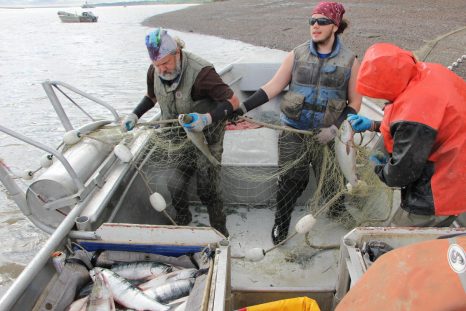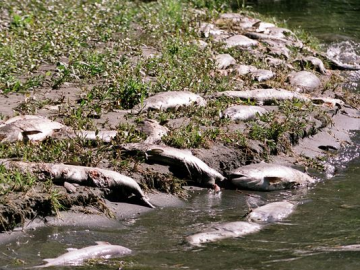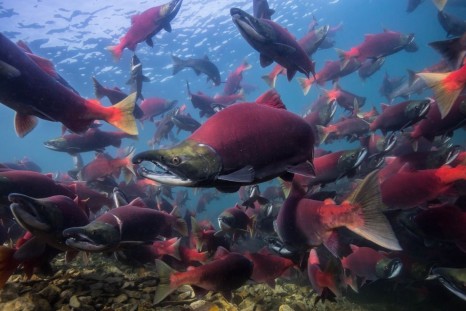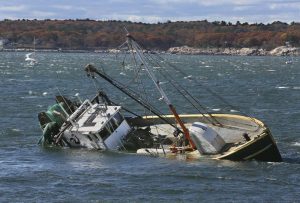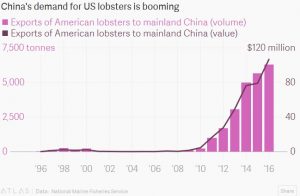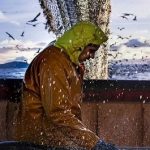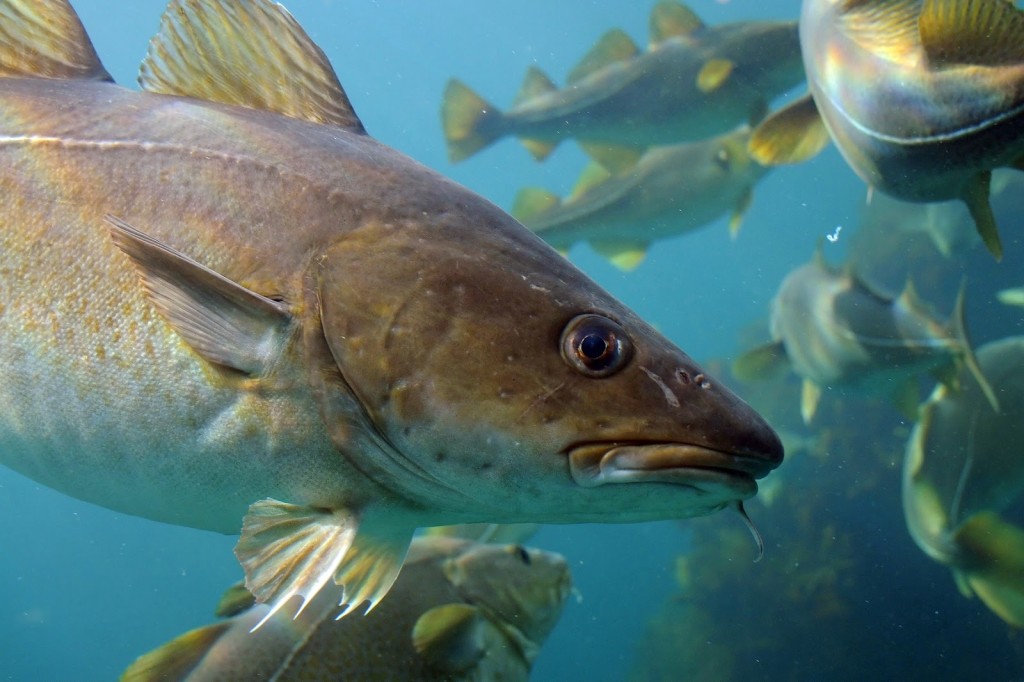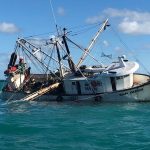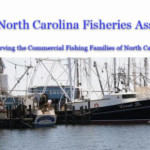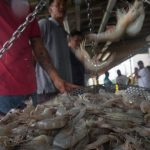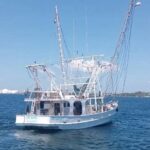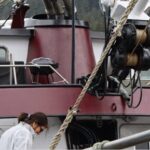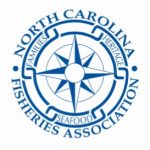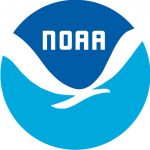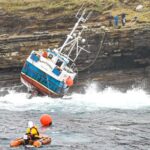Tag Archives: sockeye salmon
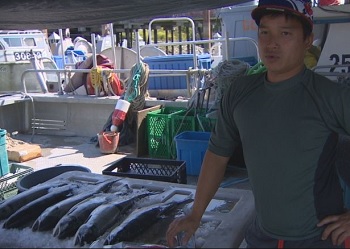
‘Gorgeous fish’: Steveston fishery workers haul in sockeye salmon bounty
Trung Nguyen, selling sockeye off his boat at the Steveston Pier for $8 a pound, has been waiting four years for this moment. Nguyen and other commercial fishery workers returned to the Richmond harbour Thursday with coolers full of salmon after being allowed out on the Fraser River Wednesday to catch salmon. The 2018 run is expected to be the biggest since 2014 and fishery workers had 24 hours to take advantage of the bounty. Strong runs come in four-year cycles and this year’s could eclipse 20 million fish. “Nice and firm. Gorgeous fish,” Nguyen said, showing a potential buyer an example of his haul. “We haven’t had an opening for four years, so this is a big year.” >click to read<09:46
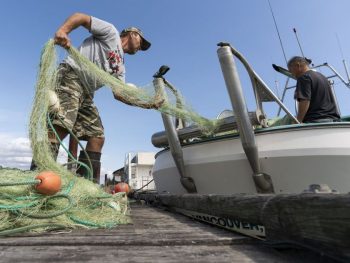
Fraser River sockeye salmon fishing bonanza to start next week
The Fraser River will open next week for its first sockeye salmon run of the season, in a year that is expected to bring in millions of fish for the first time in four years. For local fishermen, it’s better than Christmas. “Oh, we’re super excited,” said Richmond fisherman Roy Jantunen, hours after learning the Pacific Salmon Commission had announced a 24-hour opening from 7 a.m. Wednesday. Jantunen is preparing to go flat out for that full day, without any sleep, to maximize his catch. “It’s great news,” he said. “Last week, we were pulling out the nets and getting them ready. We haven’t used these nets in four years.” >click to read<08:08
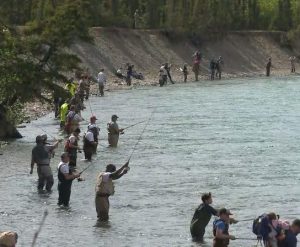
Kenai River anglers ask for closure of Cook Inlet commercial set netting
The Kenai River Sportfishing Association (KRSA) is calling for the closure of set net fishing on the Cook Inlet until adequate numbers of king and sockeye salmon enter the Kenai River. The organization is asking Gov. Bill Walker to direct the Alaska Department of Fish and Game to take action and help Kenai River salmon numbers rebound.,,, One commercial set netter agrees a closure could benefit harvests for both sides. “As a commercial set netter for almost 50 years, and speaking for myself,” Ken Coleman said, “I believe we commercial fisherman have always been in favor of department closures when the health of the fisheries is at risk, whether it be sockeyes, or Chinook or other species. >click to read<08:24
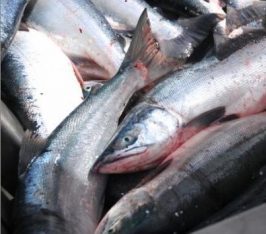
Bristol Bay sockeye harvest breaking records as other districts suffer
The Nushugak District in Bristol Bay is experiencing an all-time record harvest of sockeye salmon as other districts across Alaska suffer poor returns. “Last year the Nushagak set an all-time record of 12.3 million fish for the year, I just got off the phone [on Friday] with the manager and he expects that record to be broken today,” said Art Nelson, a spokesperson for commercial fisheries at the Alaska Department of Fish and Game. “And there are more fish to come.” Other districts across Alaska have been struggling with poor sockeye harvests. >click to read<08:44
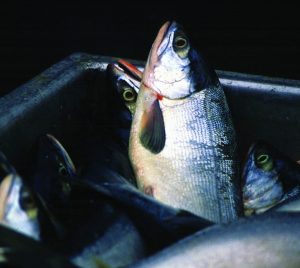
Salmon struggles extend to unprecedented restrictions at Chignik
A tough sockeye salmon commercial fishing season is shaping up in the Gulf of Alaska, from the Copper River across to Kodiak Island and back to the mainland at Chignik. And the Yukon River is seeing dismal chinook salmon returns, although the summer chum run is strong. “I haven’t put my net in the water once,” complained Chignik purse seiner Roger Rowland on June 26. “It’s literally the worst run ever.” Rowland commented from the fishing district on his cellphone, via teleconference in an Unalaska City Council meeting, about 300 miles to the southwest where he lives, during a break between votes. >click to read< 18:36

Horrible timing
The Alaska Department of Fish and Game was Wednesday lobbying Alaska residents to buy Chitina dipnet permits to fish the Copper River even as the troubled, 2018 return of sockeye salmon to that big, muddy drainage was fading so badly that Cordova commercial fishermen pleaded to have the dipnet fishery shut down. “As of today sonar counts are well below projected counts and remain below the minimum threshold of 360,000 sockeye salmon for spawning escapements,” the Cordova District Fishermen United said in a letter to state officials. “In light of the weak early run component, restrictive closures on commercial fishing openers, and no noticeable increase in counts at the sonar currently, it is in the best interest of our sockeye runs to close the Copper River personal use and sport fisheries.” >click to read<18:26
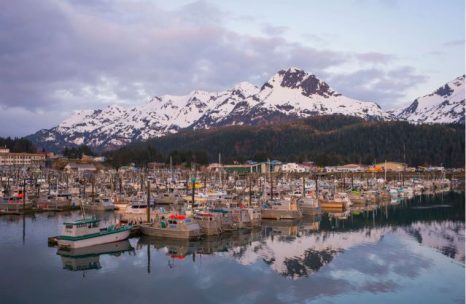
Cordova disaster?
The Copper River commercial salmon fishery will remain closed on Monday, leaving about 550 gillnet fishermen in Cordova to sit in port and ponder what is increasingly looking like a disaster for what is pound-for-pound Alaska’s most valuable sockeye run. Favored fad-fish of high-scale restaurants, Copper sockeye had a reported price on their heads of $8.50 to$9.50 per pound when the season opened, and everything looked good-to-go despite a below-average, pre-season sockeye forecast. >click to read<09:53
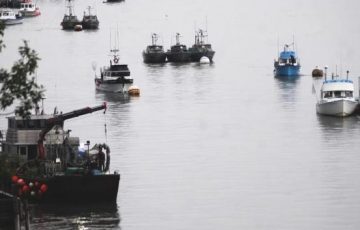
Upper Cook Inlet – Commercial fishermen to open with regular periods
Commercial fisheries managers in Cook Inlet are moving forward with a cautious eye on salmon runs but relatively normal fishing regulations for the summer. An Alaska Department of Fish and Game announcement released Friday detailed the 2018 commercial salmon fishing management strategy for Upper Cook Inlet. Managers are predicting a somewhat lower Kenai River late-run king salmon return, but it’s still within the sustainable escapement goal; the sockeye salmon forecast for the Kenai River is predicted to be 2.5 million, which is about 1.1 million less than the recent 20-year average. >click to read<08:04

The Secret Lives of Commercial Fishermen – Corey Arnold
In the early 2000s, Corey Arnold worked on commercial fishing boats in some of the world’s most dangerous waters, taking photos of the job whenever he had the chance. Soon galleries and magazines were paying attention. In 2008, Arnold shot a story for Outside in Bristol Bay, Alaska, about environmental threats from the proposed Pebble Mine. During that assignment, he discovered a seasonal fishing community at Graveyard Point, near the mouth of the Kvichak River, and established his own salmon operation. (An excellent photo article.) >click to read<16:50
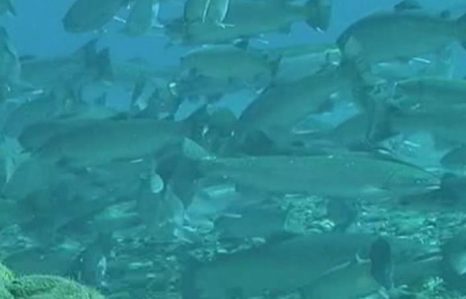
Bumper sockeye salmon run forecast for Bristol Bay in 2018
The Alaska Department of Fish and Game is forecasting another bumper year for sockeye salmon in 2018. An expected 51 million sockeye could return, with 37 million set aside for commercial fishing. “All systems are expected to meet their spawning escapement goals,” wrote the ADF&G in a news release. The bumper forecast comes amidst debate about whether to open the controversial Pebble Mine, a move that supporters say would bring growth and economic activity to the region. Detractors say the mine would harm the profitable watershed. click here to read the story 08:39
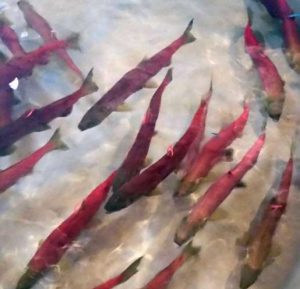
Experts: Idaho hatchery built to save salmon is killing them
A relatively new $13.5 million hatchery intended to save Snake River sockeye salmon from extinction is instead killing thousands of fish before they ever get to the ocean, and fisheries biologists in Idaho think they know why. The Department of Fish and Game in information released this week says water chemistry at the Springfield Hatchery in eastern Idaho is so different from that in the central region that the young fish can’t adjust when released into the wild. Idaho Rivers United, an environmental group, blasted the report as more reason for removing four dams on the lower Snake River that impede salmon click here to read the story 10:53
Board of Fisheries declines request to cap Kodiak sockeye harvest
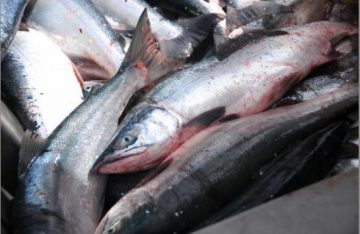 The Board of Fisheries won’t take up an out-of-cycle request to cap Kodiak sockeye salmon harvests during certain periods of the season, though it won’t be the last time the issue comes up. The board declined to accept an agenda change request that proposed a new management plan for the commercial purse seine fishery in the Kodiak Management Area setting weekly and seasonal limits on sockeye salmon harvest. The request, submitted by the United Cook Inlet Drift Association, raises concerns brought to light in a recent Alaska Department of Fish and Game genetic study showing that Kodiak seiners catch hundreds of thousands of Cook Inlet-bound sockeye salmon during the summer. click here to read the story 08:57
The Board of Fisheries won’t take up an out-of-cycle request to cap Kodiak sockeye salmon harvests during certain periods of the season, though it won’t be the last time the issue comes up. The board declined to accept an agenda change request that proposed a new management plan for the commercial purse seine fishery in the Kodiak Management Area setting weekly and seasonal limits on sockeye salmon harvest. The request, submitted by the United Cook Inlet Drift Association, raises concerns brought to light in a recent Alaska Department of Fish and Game genetic study showing that Kodiak seiners catch hundreds of thousands of Cook Inlet-bound sockeye salmon during the summer. click here to read the story 08:57
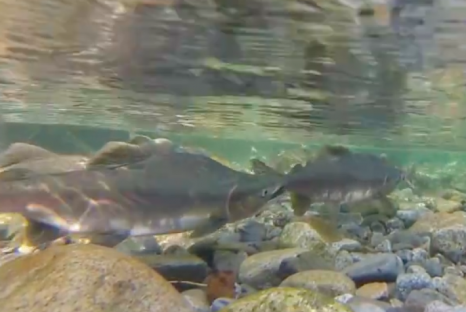
British Columbia: What is behind the sockeye salmon collapse?
The sockeye salmon run this year, is, according to Fisheries and Oceans Canada and other reputable sources, down considerably. The reason for this, depends on who you talk to. Aaron Hill, executive director of Watershed Watch Salmon Society, says part of the problem is the fisheries ministry has dragged its feet on the Cohen Commission recommendations. The Cohen Commission, created in 2009, issued a report in 2012 with 75 recommendations on how Fisheries and Oceans Canada (working with its provincial partner) could monitor and safeguard the Pacific salmon fisheries. click here to read the story 11:43
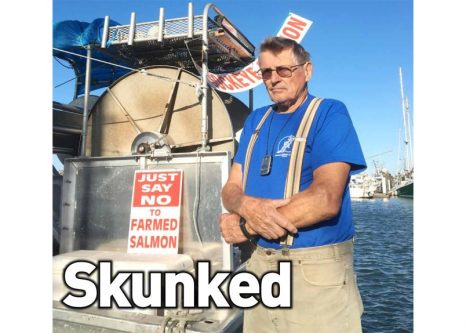
No feast during sockeye famine in Richmond
For a second year in a row, all commercial fishing of the Fraser River’s sockeye salmon has been closed by the Fraser River Panel, the regulatory body that assesses annual salmon runs. Only 1.7 million sockeye are expected to return to the Fraser this year, which is just over a third of the 4.4 million that were expected at the start of the year.,,, The closure should put a premium price on salmon for consumers, according to local fisherman Gus Jacobson. click here to read the story 18:47
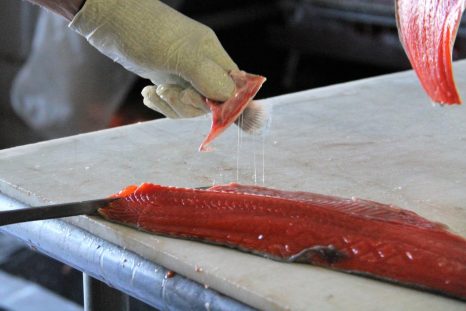
Wild Alaskan Salmon and Seafood: Quality over quantity
Wild Alaskan Salmon and Seafood is a family owned business, processing 25,000 pounds of salmon per day. Inside the plant 13 workers are hard at work. They work long hours, sometimes pulling 22 hour shifts, but morale is high, music is on and people are joking. James Sumrall, assistant manager, said everyone is friends. “When we come here being such a small and tight knit crew it’s kinda like we’re hanging out here. It’s steady and hard work but it’s kinda like we’re hanging out,” he said. “No type of overbearing hand that’s telling you work harder, work faster. Obviously we keep a good pace, but it’s a lot friendlier, moral stays high.” Wild Alaskan Salmon and Seafood is owned by Tony and Heather Woods. Most of the salmon processed at the facility is caught by drifter Tony himself. In fact, he was not available for an interview because he is out fishing the tail end of the season. Audio, click here to read the story 20:09
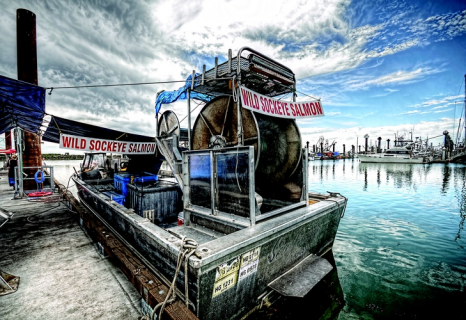
B.C. fishermen facing limited or no openings for sockeye
Commercial fishermen in B.C. won’t be getting many – if any – opportunities to harvest sockeye salmon this year, though they may be able to at least net some pink salmon. This year’s Fraser River sockeye return is expected to be low, based on historical patterns, and the early signs are that they are coming in even lower than forecast. Nass and Skeena River sockeye aren’t doing any better. The only runs that seem to be doing relatively well are Somass River sockeye and Central Coast chum salmon. No commercial opening had been expected for Somass sockeye, but returns were strong enough to allow for a small opening for seine and gillnet fisheries. click here to read the story 09:05
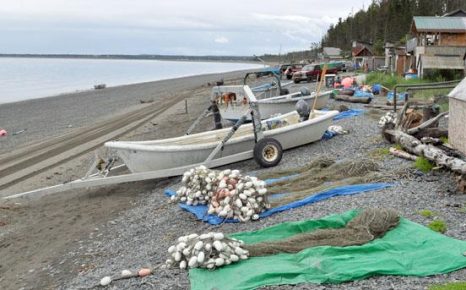
Commercial fisheries in Upper Cook Inlet open again as sockeye run continues
Commercial fishing resumed in Upper Cook Inlet this weekend. The Department of Fish and Game made the announcement Friday after fishing had been closed for the prior week. Commercial fisheries manager Pat Shields says the numbers of sockeye entering the Kenai river have been ticking up all week. “We’ve been continuing to closely monitor sockeye salmon passage into the Kenai river. The last few days have seen increased passage. It came down a bit Thursday, but 72,000 on Wednesday. Friday’s count in the Kenai through 7 a.m. is the highest morning count we’ve had this year. So we expect simliar passage (as) the last few days. We now can project that we’re going to end up in the goal range for Kenai river, which is 900,000 to 1.1 million. click here to read the story 22:19
Single-day catch of 1 million sockeye buoys Nushagak fishermen in Bristol Bay
 A million salmon caught in a day isn’t unheard of in the wildly productive Bristol Bay commercial fishery, but for one district it proved to be a record. Whether the early bonanza is a harbinger of a strong season, though, remains to be seen. Commercial fishermen in Bristol Bay’s Nushagak district caught a little over 1 million prized sockeye salmon Monday, the largest single-day catch in the Nushagak fishery. Typically, Bristol Bay catches peak around July 4. While million-plus days have happened in other Bristol Bay fisheries, they’re rarely seen in the Nushagak, a smaller fishery than the Naknek-Kvichak district to the east. The bay, considered the premier red salmon fishery in the country, is divided into five management districts based on the nine major river systems in the region. click here to read the story 17:17
A million salmon caught in a day isn’t unheard of in the wildly productive Bristol Bay commercial fishery, but for one district it proved to be a record. Whether the early bonanza is a harbinger of a strong season, though, remains to be seen. Commercial fishermen in Bristol Bay’s Nushagak district caught a little over 1 million prized sockeye salmon Monday, the largest single-day catch in the Nushagak fishery. Typically, Bristol Bay catches peak around July 4. While million-plus days have happened in other Bristol Bay fisheries, they’re rarely seen in the Nushagak, a smaller fishery than the Naknek-Kvichak district to the east. The bay, considered the premier red salmon fishery in the country, is divided into five management districts based on the nine major river systems in the region. click here to read the story 17:17
2017 Bristol Bay sockeye forecast in line with recent average
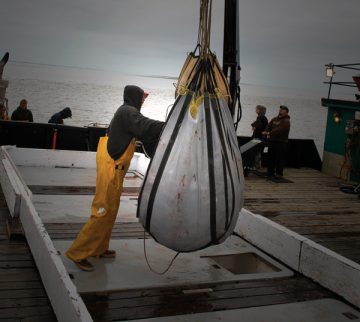 Bristol Bay can look forward to a regular season in 2017 after two years of hard work, if the forecast is to be believed. Alaska’s largest sockeye run has blown past projections the last two years, but next year the Alaska Department of Fish and Game predicts an average harvest. “A total of 41.47 million sockeye salmon (range 31.20–51.73 million) are expected to return to Bristol Bay in 2017,” according to an ADFG report released Nov. 15. “This is virtually identical to the most recent 10-year average of Bristol Bay total runs (41.39) and 27 percent greater than the long-term mean of 32.76 million.” For commercial fishermen, this means next year’s harvest will also be average, with a commercial harvest of 29 million. “A Bristol Bay harvest of this size is 2 percent lower than the most recent 10-year harvest which has ranged from 15.43 million to 37.53 million, and 34 percent greater than the long-term harvest average of 20.52 million fish (1963 to present),” the report states. Read the rest here 15:14
Bristol Bay can look forward to a regular season in 2017 after two years of hard work, if the forecast is to be believed. Alaska’s largest sockeye run has blown past projections the last two years, but next year the Alaska Department of Fish and Game predicts an average harvest. “A total of 41.47 million sockeye salmon (range 31.20–51.73 million) are expected to return to Bristol Bay in 2017,” according to an ADFG report released Nov. 15. “This is virtually identical to the most recent 10-year average of Bristol Bay total runs (41.39) and 27 percent greater than the long-term mean of 32.76 million.” For commercial fishermen, this means next year’s harvest will also be average, with a commercial harvest of 29 million. “A Bristol Bay harvest of this size is 2 percent lower than the most recent 10-year harvest which has ranged from 15.43 million to 37.53 million, and 34 percent greater than the long-term harvest average of 20.52 million fish (1963 to present),” the report states. Read the rest here 15:14
Warm water blamed for lowest sockeye salmon run on record
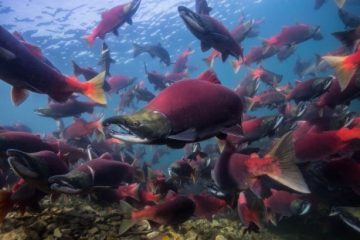 Warm summer temperatures may have Lower Mainlanders feeling good, but they are proving lethal for sockeye salmon. The Pacific Salmon Commission recently revised its already low forecast for sockeye numbers from 2.3 million to 1.1 million in the Fraser River, which would be the lowest number since records have been kept. As of August 12, the DFO has suspended all sockeye fisheries in response. John Reynolds, professor of aquatic ecology and conservation at Simon Fraser University, said three main factors are contributing to this year’s low numbers: a small parental generation; a “blob” of warm water in the Pacific Ocean; and higher-than-normal temperatures in the Fraser River. Sockeye spawn over a four-year cycle, and Reynolds said the last cycle’s already low numbers meant low numbers were a distinct possibility for this year. Read the rest here 11:39
Warm summer temperatures may have Lower Mainlanders feeling good, but they are proving lethal for sockeye salmon. The Pacific Salmon Commission recently revised its already low forecast for sockeye numbers from 2.3 million to 1.1 million in the Fraser River, which would be the lowest number since records have been kept. As of August 12, the DFO has suspended all sockeye fisheries in response. John Reynolds, professor of aquatic ecology and conservation at Simon Fraser University, said three main factors are contributing to this year’s low numbers: a small parental generation; a “blob” of warm water in the Pacific Ocean; and higher-than-normal temperatures in the Fraser River. Sockeye spawn over a four-year cycle, and Reynolds said the last cycle’s already low numbers meant low numbers were a distinct possibility for this year. Read the rest here 11:39
Bristol Bay reds late again; late run Kenai kings start strong
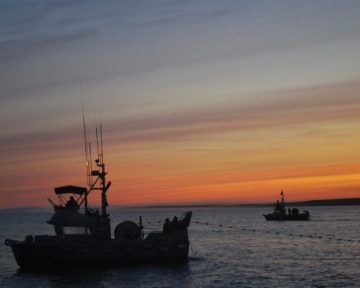 It’s the second late run in a row for the state’s most valuable salmon fishery, and the late run of king salmon in the state’s most popular river are showing up early in strong numbers. Bristol Bay, the world’s largest wild sockeye salmon producing region, experienced a massive late run of sockeye salmon last year, contributing with other market forces to drop the ex-vessel price of salmon to 50 cents per pound, or about half the historic average. This year, most signs point to a similarly late run. Late doesn’t necessarily mean below forecast. Last year, the historical midpoint of July 4 came and went with only 8.87 million fish harvested, about 35 percent less than the five-year average. All signs pointed to a Bristol Bay harvest of less than 20 million fish. By the end of the season, a late burst of sockeye produced one of the largest runs on record. Read the rest here 16:19
It’s the second late run in a row for the state’s most valuable salmon fishery, and the late run of king salmon in the state’s most popular river are showing up early in strong numbers. Bristol Bay, the world’s largest wild sockeye salmon producing region, experienced a massive late run of sockeye salmon last year, contributing with other market forces to drop the ex-vessel price of salmon to 50 cents per pound, or about half the historic average. This year, most signs point to a similarly late run. Late doesn’t necessarily mean below forecast. Last year, the historical midpoint of July 4 came and went with only 8.87 million fish harvested, about 35 percent less than the five-year average. All signs pointed to a Bristol Bay harvest of less than 20 million fish. By the end of the season, a late burst of sockeye produced one of the largest runs on record. Read the rest here 16:19
Bristol Bay buyers say they can handle full 2016 sockeye run
A survey of the 12 primary processors in Bristol Bay says that they should be able to handle more sockeye than are forecast to be caught this summer. But that’s not a guarantee that fishermen won’t be placed on limits. Each winter, the Alaska Department of Fish and Game surveys the main Bristol Bay processors to get a sense of how many fish they can handle. This year, the major processors, which operate 16 facilities, said they can process 35.5 million fish. That’s more than the 29.5 million harvest forecast. Read the article, Click here 12:50
Strong sockeye run for Upper Cook Inlet, weaker run for Lower Cook Inlet
 The Upper Cook Inlet commercial fishing industry will see a spike in sockeye salmon harvest this year, if the Alaska Department of Fish & Game’s forecast holds true. Fish & Game forecast a total of 7.1 million sockeye salmon to return to the Upper Cook Inlet streams and rivers, with 4.1 million allocated to commercial harvest. That number is about 1.1 million more than the 20-year average and about 1 million more than the total commercial harvest in 2015. Most of the increase will be fish headed for the Kenai River, which will see approximately one million more sockeye salmon than the 20-year average, according to Fish & Game’s forecast. Read the rest here 08:27
The Upper Cook Inlet commercial fishing industry will see a spike in sockeye salmon harvest this year, if the Alaska Department of Fish & Game’s forecast holds true. Fish & Game forecast a total of 7.1 million sockeye salmon to return to the Upper Cook Inlet streams and rivers, with 4.1 million allocated to commercial harvest. That number is about 1.1 million more than the 20-year average and about 1 million more than the total commercial harvest in 2015. Most of the increase will be fish headed for the Kenai River, which will see approximately one million more sockeye salmon than the 20-year average, according to Fish & Game’s forecast. Read the rest here 08:27
Scientist captures amazing photos of massive Alaskan sockeye salmon run
If the realms of science and art seems worlds away from each other, you’d be gravely mistaken. After all, when you’re studying the science behind the world around us, how can you not feel inspired by its sublime beauty? That’s why it should come as no surprise to learn that some of society’s most creative and passionate artists also happen to possess brilliant scientific minds. One such scientist is Jason Ching, a Washington-based researcher who has spent years studying and photographing Bristol Bay’s Sockeye Salmon populations. Video, Read the article here, and visit JasonChing.com 12:11
Bristol Bay sockeye earnings hit decade low
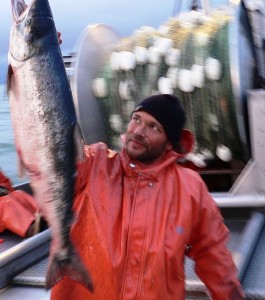 For the first time in a decade, ex-vessel earnings for sockeye salmon coming out of Bristol Bay, Alaska, have fallen below $100 million, despite a “massive” return of 58m fish, according to a sockeye bi-annual market analysis prepared for the Bristol Bay Regional Seafood Development Association by McDowell Group. According to the report, 2014 marked the fourth consecutive year that base ex-vessel prices –the price paid to fishermen by a processor for whole fish — were above $1.00/lb, “Bristol Bay seemed to be on a roll; firing on all cylinders and producing strong earnings”. Value fell sharply, however, in 2015,,, Read the rest here 14:00
For the first time in a decade, ex-vessel earnings for sockeye salmon coming out of Bristol Bay, Alaska, have fallen below $100 million, despite a “massive” return of 58m fish, according to a sockeye bi-annual market analysis prepared for the Bristol Bay Regional Seafood Development Association by McDowell Group. According to the report, 2014 marked the fourth consecutive year that base ex-vessel prices –the price paid to fishermen by a processor for whole fish — were above $1.00/lb, “Bristol Bay seemed to be on a roll; firing on all cylinders and producing strong earnings”. Value fell sharply, however, in 2015,,, Read the rest here 14:00
Bristol Bay 2015 season summary: 3rd-largest run ever
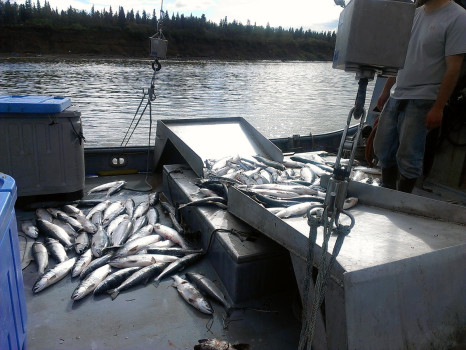 The Department of Fish and Game released a summary of the Bristol Bay 2015 fishing season, now noting a total inshore run of 58 million sockeye salmon. That makes 2015 a near-record-setting year, says Fish and Game area biologist Tim Sands. “It’s second out of the last 20 years – the only one that beat it was 1995 – and it’s the third-largest run of all time,” said Sands. This year’s harvest was counted at 37.6 million sockeye, which Sands say is the fourth largest ever, using records going back to the 1880s. Read the rest here 20:52
The Department of Fish and Game released a summary of the Bristol Bay 2015 fishing season, now noting a total inshore run of 58 million sockeye salmon. That makes 2015 a near-record-setting year, says Fish and Game area biologist Tim Sands. “It’s second out of the last 20 years – the only one that beat it was 1995 – and it’s the third-largest run of all time,” said Sands. This year’s harvest was counted at 37.6 million sockeye, which Sands say is the fourth largest ever, using records going back to the 1880s. Read the rest here 20:52
Sockeye face ‘catastrophic’ collapse in South Okanagan
 A potentially catastrophic collapse of the sockeye salmon run is unfolding on the Columbia River system this year. Scientists once predicted that about 100,000 sockeye would return to spawning grounds in the rivers and streams in British Columbia’s South Okanagan region. In fact, it was supposed to be one of the largest sockeye runs in recent history, said Okanagan Nation Alliance fish biologist Richard Bussanich. Read the rest here 14:51
A potentially catastrophic collapse of the sockeye salmon run is unfolding on the Columbia River system this year. Scientists once predicted that about 100,000 sockeye would return to spawning grounds in the rivers and streams in British Columbia’s South Okanagan region. In fact, it was supposed to be one of the largest sockeye runs in recent history, said Okanagan Nation Alliance fish biologist Richard Bussanich. Read the rest here 14:51






